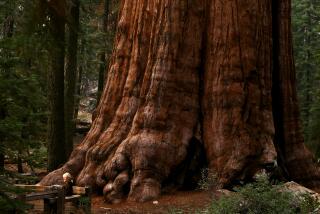New Species Threatening U.S. Parks
- Share via
WASHINGTON — From gypsy moths in the Shenandoah to wild pigs in the Great Smokies to creeping kudzu in the West, an invasion of exotic animal and plant species is threating the nation’s national parks.
A draft summary of a major, just-completed National Park Service assessment of the condition of natural and cultural resources lists “encroachment by plants and animals not native to park environments” ahead of any other “major issues and threats” to natural resources.
Sometimes the invasion is part of the ebb and flow of nature, as with gypsy moths attacking trees in Virginia’s Shenandoah National Park. Sometimes it is the end of a complex process kicked off by humans, as in the replacement of sawgrass with cattail plants in the Everglades National Park in Florida as a result of fertilizer-laden water entering the swamp. That changes the whole food chain in the park.
Sometimes it isn’t easy to decide, as with the ravages of vegetation caused by wild pigs in the Great Smoky Mountains National Park in Tennessee and North Carolina or goats in Olympic National Park in Washington State, or the invasion of kudzu or eucalyptus at several sites in the South or West.
Sometimes nothing can really be done as nature slowly replaces one species with another over the course of a century or so.
In an interview, parks director William Penn Mott said: “In the Florida Everglades we have the invasion of the Brazilian pepper, we have the invasion of the Australian pine. . . . It may be there is no way on God’s green Earth that we can eliminate the pepper, for example. . . . Over a period of time, it may be that will be the ecology of the Florida Everglades.”
Mott’s deputy, Denis P. Galvin, added: “It seems to me one of the roles of the national parks is to illustrate that kind of process.”
There are few really new individual facts about exotic species in the study, just their appearance in different places.
“What the assessment points out is that exotic plants and animals are a problem in more places than we would have thought,” said Galvin.
The study, launched by Mott when he took over the service two years ago, is the first of its kind since park managers were asked to list threats to their units in 1980. Results of the exercise, which will be repeated every three years, have been computerized for easy access throughout the park system.
Funds from new and increased visitor fees will be directed at what park managers judge the most important problems uncovered in the assessment. This will mean an extra $52 million a year before collection expenses, with 10% of the net reserved for a special director’s discretionary fund, to be spent on research and protection of resources or interpretation for visitors.
Nearly 60% of park managers said their installations were threatened in one way or another, one-third of them by activities outside park boundaries.
Most natural resources were judged in fair condition, with only 15% described as poor. But the managers said they needed to undertake 2,500 projects over the next three years at what the service estimated would be $250 million to $300 million, a sum that it noted “far exceeds the current NPS budget.”
For cultural resources--roughly half the units in the system commemorate something--managers said a quarter of the sites, a third of the buildings and a third of the collections were in good condition. Most sites and structures that are well documented “are relatively free of serious adverse impacts.”
“But the status of many cultural resources is unknown because of an enormous backlog of historical research, documentation, inspections and cataloguing,” the summary said in noting that only 12% of its museum collections had been catalogued.
More to Read
Sign up for Essential California
The most important California stories and recommendations in your inbox every morning.
You may occasionally receive promotional content from the Los Angeles Times.











